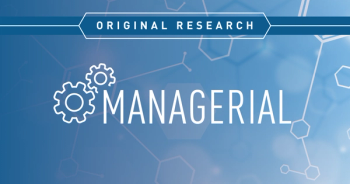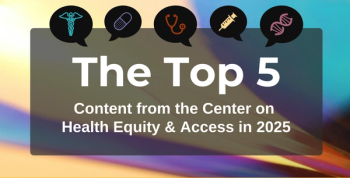
- August 2025
- Volume 31
- Issue Spec. No. 9
- Pages: SP548-SP552
On the Path to Greater Precision in Treating Multiple Myeloma
Key Takeaways
- Multiple myeloma treatment has advanced with new therapies, increasing life expectancy from under 3 years to over a decade.
- Health disparities persist, with Black patients facing higher diagnosis rates and worse outcomes, necessitating inclusive clinical trials.
Past efforts to collect data and to understand the relationship between minimal residual disease and outcomes will help researchers in multiple myeloma develop a new generation of targeted therapies, decide when treatment can be stopped, and possibly screen populations for the disease.
Few success stories in medicine can compete with the progress in treating multiple myeloma. In just over 20 years, standard treatment has shifted from chemotherapy and corticosteroids, with possibly an autologous stem cell transplant (ASCT), to nearly 20 new therapies along with new delivery methods.1,2
Multiple myeloma is the second most common blood cancer in the US, with 36,110 new diagnoses expected this year. It starts in plasma cells in the bone marrow and can be hard to diagnose because early symptoms resemble other conditions, such as diabetes.3 Life expectancy has more than tripled from less than 3 years to more than a decade,4 and a modeling study suggests that a 4-drug combination given to newly diagnosed patients could work up to 17 years.5
Both the number of drugs and the diversity of drug classes mean patients and their physicians have a bounty of options. In fact, one of today’s challenges is deciding how drugs should be sequenced for maximum benefit.6
In some ways, innovation in multiple myeloma is just beginning. It’s not just about new therapies, although many are in the pipeline. Thanks to new tests and the rise of artificial intelligence (AI), investigators are pursuing more individualized treatments and seeking answers to research questions in a fraction of the time once needed.7,8 Treatment may move into an earlier phase of the disease, before full-blown myeloma arrives.9 Additionally, population-level screening—think mammograms or colonoscopies—could be possible for multiple myeloma, which is a worthwhile goal given rising numbers of patients diagnosed worldwide.10
Hearn Jay Cho, MD, PhD, chief medical officer for the Multiple Myeloma Research Foundation (MMRF), says the group’s wins should be celebrated, but the word “cure” remains elusive. MMRF’s research agenda seeks to change that, he said in an interview with Evidence-Based Oncology (EBO).
“There’s been so much progress in the field—a lot of it driven by research that the foundation was involved in—so there’s a lot of hope. There are all these great new treatments,” he said. “There’s still a need for more research [and a] better understanding of the biology of the disease.”
New trials, new combinations, and new sequences all point to curative therapy, he said, and not just for some patients. Access should be available “no matter where you live [and] no matter what your resources.”
Until that happens, Cho said, “The job is not done.”
Achieving Equity in Myeloma Treatment
For all the good news, the multiple myeloma landscape has lingering challenges. Black individuals are twice as likely to be diagnosed with multiple myeloma as White individuals, and Black patients have worse outcomes.11 They remain underrepresented in clinical trials, even though Black individuals account for 20% of all new cases in the US, a share that is projected to rise to 24% by 2034.12 Amid a political climate in the US that discourages research about underrepresented populations, both the MMRF and the International Myeloma Foundation (IMF) are committed to closing gaps.13,14
Cho noted that the MMRF hosts a health equity summit that examines differences not only between racial and ethnic groups but also between urban and rural communities. “If you’re going to do a clinical trial in the United States, you should have 20% African American patients in the trial, but that’s not the only disparity,” he said.
Right now, Cho said, 80% of patients with myeloma are treated in the community, not in academic centers. “There are people who live in rural areas. There are people who are [older]. There are people who may have different levels of resources [that affect outcomes],” he said. “How do we ensure that clinical trials and cutting-edge, modern treatments are available to the broadest myeloma patient population?”
Through its M-Power initiative, the IMF is deepening community-level ties and mentoring a new generation of medical students, with the goal of building trust that will bring more patients into clinical trials. IMF Chief Medical Officer Joseph Mikhael, MD, MEd, FRCPC, a professor at City of Hope’s Translational Genomics Research Institute, told EBO there’s a recognition that progress will take time. For example, mentoring students may produce more myeloma specialists, but if some become primary care physicians who are better able to spot signs of the disease, that’s useful, too.
“The idea here is: If we’re going to achieve health equity [and] help reduce these disparities, it’s not going to be done overnight,” Mikhael said. “It takes a long time, and part of the long game is training a generation of doctors who are familiar with these disparities, understand them, and [who] represent their community and can provide better health care to all, whether they become myeloma doctors or not.”
MMRF’s Translational Research Umbrella
Launched in 1998, the MMRF has taken a multipronged approach of supporting external research into new therapies while managing its own agenda, which has created data sets useful across investigations. Starting in 2013, results gathered through the CoMMpass study (NCT01454297) have been used in more than 200 projects. These data were leveraged in the MyDRUG study (NCT03732703) to identify new treatment targets.15 Then, in 2019, the MMRF launched the Immune Atlas to learn more about the immune microenvironment in bone marrow, where myeloma cells emerge.16
Today, Cho said, the MMRF seeks to understand how therapies work in the body over time, especially with the number of immunotherapies approved in recent years, from monoclonal and bispecific antibodies to chimeric antigen receptor (CAR) T-cell therapy. “Are there genomic, tumor, and immune factors that will help us understand the outcomes [and] to use those therapies better or develop new therapies?”
To answer this question, the MMRF has created a “translational research umbrella,” which Cho said “is intentionally designed to quickly ask important questions and get answers in a reasonable period of time.”
Knowledge gained from CoMMpass and the Immune Atlas has helped researchers learn more about the biological factors of myeloma. “Now we can address very focused questions,” Cho said. “For example, if patients are getting CAR T cells and bispecific T-cell–redirecting agents today, what does their immune system and tumors look like before they start the treatment? And how does that change with the treatments?”
These questions are central to the question of how to sequence therapies. A key decision in treatment today is whether patients should receive CAR T-cell therapy before a bispecific or afterward. Although cost and access to a treatment center may factor into the equation, the most central question is: What works best? Cho said some research suggests that patients who receive CAR T-cell therapy first and then a bispecific after a relapse have better response rates than when the order is reversed.17 The work that the MMRF is doing, however, will allow physicians to make those decisions based on individual patient characteristics.
First up under the umbrella are the HORIZON studies, which Cho said will speed up the process of finding novel treatments through an adaptive platform design. HORIZON-ONE (NCT06171685) will evaluate patients with relapsed/refractory (R/R) disease, starting with assessments of optimal doses of the bispecific T-cell engager (BiTE), teclistamab (Tecvayli). HORIZON-TWO will examine patients who are newly diagnosed with high-risk disease.18
By collecting samples and clinical information and then examining tumors and the immune microenvironment over time, Cho said the research will track patients “as they respond to the treatment, as they go into remission, and [whether] they relapse.” He went on to ask the question: “How does it look when they relapse? How is that different?” And, perhaps most important, “Are we going to find clues for why these therapies fail?”
By using AI to process the reams of data accumulated through this process, Cho expects the MMRF will learn quickly what makes therapies effective—or not. “We are going to look for different targets to make these therapies work better,” he said. “Instead of taking 11 years to get an answer, we can answer that question in 2 or 3 years, and that’s going to help us design better clinical trials [and] look for better treatments.”
New Therapies, More in the Pipeline
Last year’s big news in multiple myeloma included a pair of FDA approvals for rival quadruplets to treat patients newly diagnosed with multiple myeloma; each combined an anti-CD38 therapy with bortezomib (Velcade), lenalidomide (Revlimid), and dexamethasone. A quadruplet with subcutaneous daratumumab and hyaluronidase-fihj (Darzalex Faspro; Janssen) received approval in July 2024 as an induction and consolidation therapy for patients eligible for ASCT.19 Meanwhile, an isatuximab quadruplet (Sarclisa; Sanofi) received approval in September 2024 for patients not eligible for transplant.20 At the 2025 American Society of Clinical Oncology (ASCO) Annual Meeting, a subset of data from a second phase 3 study of the daratumumab quadruplet, CEPHEUS (NCT03552064), showed efficacy and minimal residual disease (MRD) negativity in transplant-ineligible patients.21
Recent FDA activity in multiple myeloma has offered mixed results, with an approval and split decisions from an advisory panel on 2 well-known therapies:
Linvoseltamab. Part of the BiTE class, linvoseltamab (Lynozyfic; Regeneron Pharmaceuticals, Inc), was approved in July 2025 based on data from the phase 1/2 LINKER-MM1 trial (NCT03761108). Although the FDA approved linvoseltamab for patients treated with at least 4 prior therapies,22 including a proteasome inhibitor, an immunomodulatory agent, and an anti-CD38 monoclonal antibody, some believe this treatment will ultimately reach a broader population.
“We really think this drug is very effective and should move earlier and earlier in the course,” said Sundar Jagannath, MBBS, a LINKER-MM1 investigator and professor of medicine at the Icahn School of Medicine at Mount Sinai.23 If the most effective therapy is given earlier, “you can cure the cancer.… You want to cure the cancer on the first go-around.”
Cho said whenever patients get more options, it’s encouraging. “Linvoseltamab belongs to a class of drugs that’s already demonstrated to be effective in multiple myeloma, and it had really excellent outcomes, so it was effective—and the safety profile was similar to other agents in this class,” he said, adding that having “another tool in the toolbox” is always beneficial when physicians present patients with options.
Belantamab mafodotin. This antibody-drug conjugate (Blenrep; GSK) has traveled quite a path: First approved via FDA’s accelerated pathway in August 2020, it was pulled from the market after a confirmatory trial did not show that the drug was superior to existing treatments.24 However, positive results for additional trials—DREAMM 7 (NCT04246047)25 and DREAMM 8 (NCT04484623)26—showed a benefit in progression-free survival relative to well-known combinations in R/R multiple myeloma. GSK went back to regulators and gained approval from the European Medicines Agency to put the drug back on the market.27 But in July, the FDA Oncologic Drugs Advisory Committee (ODAC) gave it a thumbs down, saying the risks outweighed the benefits.28 GSK CEO Emma Walmsley said on July 30, 2025, that the company has “absolutely no change in our expectations” despite the setback. The FDA’s deadline for action is October 23, 2025.29
Cho, who spoke with EBO before the ODAC meeting, said, “The bottom line is: This is an effective drug. It’s got a second chance to be approved in the United States, which is great. We are advocating for as many good options for [patients with] myeloma as possible, so we are eagerly awaiting the outcome.”
Daratumumab for smoldering myeloma (SMM). In May, the ODAC endorsed approval of the anti-CD38 therapy subcutaneous daratumumab for high-risk SMM, based on results of the AQUILA trial (NCT03301220).9 Overall, Cho said, “It’s incredibly encouraging. I think it is good news to know that there are [patients with] smoldering myeloma who benefit from treatment early on—that it delays their progression to symptomatic myeloma.”
However, in this rapidly advancing field, discussions about treating high-risk SMM are complex. During last year’s International Myeloma Society meeting, the debate over whether or how to treat SMM was lively as scientists awaited the AQUILA results. Vincent Rajkumar, MD, professor of medicine at Mayo Clinic, said SMM is a distinct clinical condition,30 separate from monoclonal gammopathy of undetermined significance (MGUS), and patients with high-risk SMM are a subset of this group. As Cho explained, the challenge of understanding the AQUILA data is that the definition of “high risk” narrowed after that study began.
“Now the challenge is figuring out who those patients are among the general population [with] smoldering myeloma,” he said. The MMRF supports education efforts to help physicians understand who is at high risk and how to interpret both the trial data and the approval.
CAR T therapies in the pipeline. Agents under development include anitocabtagene autoleucel (anito-cel; CART-ddBCMA), by Arcellx in partnership with Kite, which describes anito-cel as “the first BCMA [B-cell maturation antigen] CAR T to be investigated in multiple myeloma that utilizes Arcellx’s novel and compact D-domain binder.”31
Results from the phase 2 iMMagine-1 trial (NCT05396885), presented in June at the European Hematology Association (EHA) 2025 Congress, showed anito-cel achieved a 97% overall response rate (ORR) for patients with R/R disease treated with at least 3 prior therapies. The stringent response rate was 68%.32
Arlocabtagene autoleucel (arlo-cel; Bristol Myers Squibb) departs from the field in that this CAR T-cell therapy targets the GPRC5D protein. Data from a phase 1 trial (NCT04674813) showed an 87% overall response rate in R/R multiple myeloma, with a 53% complete response (CR) rate. The recommended phase 2 dose achieved a 91% ORR, with a 48% CR rate and 22% very good partial response rates.33
Noteworthy. Results presented at the ASCO 2025 showed Janssen’s investigational trispecific antibody—JNJ-5322, targeting BCMA, GPRC5D, and CD3—showed a 100% ORR in patients with R/R multiple myeloma not previously treated with either a BCMA- or GPRC5D-targeting therapy; 70.4% had a CR or better. Investigators reported that the novel CD3 binding domain reduced effects of cytokine release syndrome, with just 1 step-up dose needed.34
Finally, presentations at ASCO and EHA drew attention to Sanofi’s candidate for subcutaneous isatuximab, which would be delivered with an on-body injector.
Testing, Screening, and the Word “Cure”
Precision medicine approaches, and the MMRF research agenda in particular, rely on the use of testing—both circulating tumor DNA blood testing for treatment monitoring and MRD testing, which uses various methods to detect remaining cancer cells. Use of MRD made news in 2024 when ODAC endorsed its use as a component of a surrogate end point.35
Although the FDA has not yet issued a final guidance, Mikhael said MRD measures are now well established in drug development, and the IMF played a central role when it created the international working group to examine how MRD could be used for this purpose.
MRD testing, already touted as a tool to decide when treatment can stop, could lead to a long-sought goal, Mikhael said. “We would love to have fixed-duration treatment with long-term survival. Our research agenda has been built on several premises, but one of the most important things we can do is prove that someone is cured—that the disease is gone.”
The IMF is also exploring the use of testing for early detection. “This is why we do screening with mammograms for breast cancers and why we do colonoscopies for colon cancer,” Mikhael said. “Our cure strategy has been with those intentions of mind, saying, ‘Can we catch the disease early on or intervene early enough to potentially cure it?’”
Newer tools such as mass spectrometry, a highly sensitive blood test, can be used to detect and monitor MGUS and detect SMM.36 The field is waiting for the final results of iStopMM, a study in which 80,000 residents of Iceland voluntarily agreed to be screened and followed for MGUS to test the feasibility of screening.10 “We’ll know the answer within the next 2 years of whether or not screening saves lives,” Mikhael said.
Mikhael and Cho said that the combination of using today’s treatments more precisely and developing new ones offers hope.
“If you go back 35 years, there’s always been a small fraction of people…who lived over 20 years with myeloma,” Mikhael said. “With many of our current trials using quadruplets [and] sustained treatment, that fraction continues to grow. It’s still a minority, but if you go from 2% to 20%, that’s a huge step forward.”
References
1. Kyle RA, Rajkumar SV. Treatment of multiple myeloma: a comprehensive review. Clin Lymphoma Myeloma. 2009;9(4):278-288. doi:10.3816/CLM.2009.n.056
2. Gupta A, Kumar L. Evolving role of high dose stem cell therapy in multiple myeloma. Indian J Med Paediatr Oncol. 2011;32(1):17-24. doi:10.4103/0971-5851.81885
3. Key statistics about multiple myeloma. American Cancer Society. Updated February 28, 2025. Accessed July 30, 2025. https://www.cancer.org/cancer/types/multiple-myeloma/about/key-statistics.html
4. Puertas B, González-Calle V, Sobejano-Fuertes E, et al. Novel agents as main drivers for continued improvement in survival in multiple myeloma. Cancers (Basel). 2023;15(5):1558. doi:10.3390/cancers15051558
5. Sonneveld P, Zweegman S, Facon T, et al. Modeling long-term progression-free survival in transplant-eligible and transplant-ineligible newly diagnosed multiple myeloma treated with daratumumab, bortezomib, lenalidomide, and dexamethasone. Presented at: 6th European Myeloma
Network Meeting; April 10-12, 2025; Athens, Greece. Abstract B04.
6. Petrucci MT, Bringhen S, Entrala Cerezo C, Mendes J, Armeni P. Optimizing treatment sequencing in multiple myeloma: a novel model to predict survival outcomes. Hematology. 2024;29(1):2432815. doi:10.1080/16078454.2024.2432815
7. Romero M, Orgueira AM, Saldarriaga MM, et al. How artificial intelligence revolutionizes the world of multiple myeloma. Front Hematol. Published February 1, 2024. doi:10.3389/frhem.2024.1331109
8. Durie BGM. Can myeloma be monitored using only blood testing? International Myeloma Foundation. September 15, 2022. Accessed July 30, 2025. https://www.myeloma.org/videos/can-myeloma-be-monitored-using-only-blood-testing
9. Dimopoulos MA, Voorhees PM, Scjesvold F, et al. Daratumumab or active monitoring for high-risk smoldering multiple myeloma. N Engl J Med. 2025;392(18):1777-1788. doi:10.1056/NEJMoa2409029
10. With 80,000 participants, the largest study of its kind is the first to evaluate the benefits of screening for a precursor to the blood cancer multiple myeloma. International Myeloma Foundation. May 19, 2021. Accessed June 30, 2025. https://www.myeloma.org/largest-study-to-evaluate-benefits-of-precursor-MGUS-screening-multiple-myeloma
11. Mikhael J, Cichewicz A, Mearns ES, et al. Overall survival in patients with multiple myeloma in the US: a systematic literature review of racial disparities. Clin Lymphoma Myeloma Leuk. 2024;24(2):e1-e12. doi:10.1016/j.clml.2023.09.009
12. Rosenberg PS, Barker KA, Anderson WF. Future distribution of multiple myeloma in the United States by sex, age, and race/ethnicity. Blood. 2015;125(2):410-412. doi:10.1182/blood-2014-10-609461
13. Our commitment to diversity, equity, and inclusion. Multiple Myeloma Research Foundation. Accessed July 30, 2025. https://themmrf.org/about/diversity-equity-inclusion/
14. The IMF diversity, equity, and inclusion policy. International Myeloma Foundation. Accessed July 30, 2025. https://www.myeloma.org/IMF-Diversity-Equity-Inclusion-Policy
15. MMRF programs drive advances in cancer research at 64th American Society of Hematology (ASH) Annual Meeting. News release. Multiple Myeloma Research Foundation. December 12, 2022. July 30, 2025. https://themmrf.org/uncategorized/mmrf-programs-drive-advances-in-cancer-research-at-64th-american-society-of-hematology-ash-annual-meeting
16. The MMRF Immune Atlas Project. Multiple Myeloma Research Foundation. July 30, 2025. https://themmrf.org/mmrf-blogs/the-mmrf-immune-atlas-project/
17. Verma A. How to sequence CAR T-cell therapy and bispecific antibodies in relapsed/refractory multiple myeloma. Multiple Myeloma Hub. August 12, 2024. Accessed July 30, 2025. https://multiplemyelomahub.com/medical-information/symposium-or-how-to-sequence-car-t-cell-therapy-and-bispecific-antibodies-in-relapsedrefractory-multiple-myeloma
18. The Multiple Myeloma Research Foundation (MMRF) announces the first patient enrolled in its Horizon clinical trials program to accelerate the identification of optimal treatment strategies for multiple myeloma. News release. Multiple Myeloma Research Foundation. December 4, 2024. Accessed July 30, 2025. https://themmrf.org/mmrf-press-
releases/the-multiple-myeloma-research-foundation-mmrf-announces-the-
first-patient-enrolled-in-its-horizon-clinical-trials-program-to-accelerate-the-identification-of-optimal-treatment-strategies-for-multipl/
19. Darzalex Faspro (daratumumab and hyaluronidase-fihj)-based quadruplet regimen approved in the US for patients with newly diagnosed multiple myeloma who are transplant-eligible. News release. Johnson & Johnson. July 30, 2024. Accessed July 30, 2025. https://www.prnewswire.com/news-releases/darzalex-faspro-daratumumab-and-hyaluronidase-fihj-based-quadruplet-regimen-approved-in-the-us-for-patients-with-newly-diagnosed-multiple-myeloma-who-are-transplant-eligible-302210443.html
20. Sarclisa approved in the US as the first anti-CD38 therapy in combination with standard-of-care treatment for adult patients with newly diagnosed multiple myeloma not eligible for transplant. News release. Sanofi. September 20, 2024. Accessed July 30, 2025. https://www.sanofi.com/en/media-room/press-releases/2024/2024-09-20-22-36-34-2949916
21. Usmani SZ, Facon T, Hungria V, et al. Daratumumab plus bortezomib, lenalidomide and dexamethasone for transplant-ineligible or transplant-deferred newly diagnosed multiple myeloma: the randomized phase 3 CEPHEUS trial. Nat Med. 2025;31(4):1195-1202. doi:10.1038/s41591-024-03485-7
22. Lynozyfic (linvoseltamab-gcpt) receives FDA accelerated approval for treatment of relapsed or refractory multiple myeloma. Regeneron Pharmaceuticals. News release. July 2, 2025. Accessed July 2, 2025. https://investor.regeneron.com/news-releases/news-release-details/lynozyfictm-linvoseltamab-gcpt-receives-fda-accelerated-approval
23. McCormick B. Linvoseltamab approval expands access, increases competition in BCMA bispecifics space: Sundar Jagannath, MBBS. AJMC. July 30, 2025. Accessed July 30, 2025. https://www.ajmc.com/view/linvoseltamab-approval-expands-access-increases-competition-in-bcma-bispecific-therapy-space-sundar-jagannath-mbbs
24. GSK provides update on DREAMM-3 phase III trial for Blenrep in relapsed/refractory multiple myeloma. News release. GSK. November 7, 2022. Accessed July 30, 2025. https://www.gsk.com/en-gb/media/press-releases/gsk-provides-update-on-dreamm-3-phase-iii-trial-for-blenrep/
25. Hungria V, Robak P, Hus M, et al. Belantamab mafodotin, bortezomib, and dexamethasone for multiple myeloma. N Engl J Med. 2024;391(5):393-407. doi:10.1056/NEJMoa2405090
26. Dimopoulos MA, Beksac M, Pour L, et al. Belantamab mafodotin, pomalidomide, and dexamethasone in multiple myeloma. N Engl J Med. 2024;391(5):408-421. doi:10.1056/NEJMoa2403407
27. Meredith S. Blenrep gets European nod to treat multiple myeloma. Medscape. May 23, 2025. Accessed July 30, 2025. https://www.medscape.com/viewarticle/blenrep-gets-european-nod-treat-multiple-myeloma-2025a1000d3x
28. Flaherty C. FDA’s ODAC votes against risk:benefit profiles of belantamab mafodotin combos in R/R myeloma. OncLive. July 17, 2025. Accessed July 30, 2025. https://www.onclive.com/view/fda-s-odac-votes-against-risk-benefit-profiles-of-belantamab-mafodotin-combos-in-r-r-myeloma
29. Dunleavy K. Despite Blenrep uncertainty, GSK sticks to its £40B sales projection for 2031. Fierce Pharma. July 30, 2025. Accessed July 30, 2025. https://www.fiercepharma.com/pharma/despite-blenrep-uncertainty-gsk-sticks-its-ps40b-projection-2031
30. Caffrey M. Smoldering multiple myeloma: risk factors, who to treat, how to treat. AJMC. September 25, 2024. Accessed July 30, 2025. https://www.ajmc.com/view/smoldering-multiple-myeloma-risk-factors-who-to-
treat-how-to-treat
31. Kite and Arcellx continue momentum with advances in anito-cel multiple
myeloma program. News release. Kite. May 9, 2024. Accessed July 30, 2025. https://www.gilead.com/news/news-details/2024/kite-and-arcellx-continue-
momentum-with-advances-in-anito-cel-multiple-myeloma-program
32. Kaur G, Freeman CL, Dhakal B, et al. Phase 2 registrational study of anitocabtagene autoleucel for relapsed and/or refractory multiple myeloma (RRMM): updated results from iMMagine-1. Presented at: EHA2025 Congress; June 12-15, 2025; Milan, Italy. Abstract S20.
33. Bal S, Anderson LD, Nadeem O, et al. Efficacy and safety with extended follow-up in a phase 1 study of BMS-986393, a G protein-coupled receptor class C group 5 member D (GPRC5D)-targeted CAR T cell therapy, in patients (pts) with heavily pretreated relapsed/refractory (RR) multiple myeloma (MM). Blood. 2024;144(suppl 1):922. doi:10.1182/blood-2024-201356
34. van de Donk NWCJ, Vega G, Perrot A, et al. First-in-human study of JNJ-79635322 (JNJ-5322), a novel, next-generation trispecific
antibody (TsAb), in patients (pts) with relapsed/refractory multiple myeloma (RRMM): initial phase 1 results. J Clin Oncol. 2025;43(suppl 16):7505. doi:10.1200/JCO.2025.43.16_suppl.7505
35. Caffrey M. After ODAC, what’s next for MRD testing in multiple myeloma? AJMC. September 25, 2024. Accessed July 30, 2025. https://www.ajmc.com/view/after-odac-what-s-next-for-mrd-testing-in-multiple-myeloma-MRD and mass spectrometry testing.
36. International Myeloma Foundation. Updated March 11, 2025. Accessed July 30, 2025. https://www.myeloma.org/multiple-myeloma/tests-staging/mrd-mass-spectrometry-testing
Articles in this issue
Newsletter
Stay ahead of policy, cost, and value—subscribe to AJMC for expert insights at the intersection of clinical care and health economics.







































